An Online Novel Two-Layered Photovoltaic Fault Monitoring Technique Based Upon the Thermal Signatures
Abstract
:1. Introduction
2. Experimental Methodology
3. Results
3.1. Short Circuit Faults
3.2. Short Circuit Faults Validation through Thermography
3.3. Ground Faults
3.4. Ground Faults Validation through Thermography
3.5. Open Circuit Faults
3.6. Open Circuit Circuit Faults Validation through Thermography
3.7. Partial Shading Faults
4. Discussion
5. Conclusions
Author Contributions
Funding
Conflicts of Interest
Nomenclature
| Abbreviations | |
| AC | Alternating Current |
| DC | Direct Current |
| FM | Faulty Module |
| GF | Ground Fault |
| HM | Healthy Module |
| MPPT | Maximum Power Point Tracking |
| OC | Open Current |
| PV | Photovoltaic |
| SC | Short Circuit |
| Subscripts | |
| Ipm | Current at Maximum Power |
| Isc | Short Circuit Current |
| Isc,cell | Cell Short Circuit Current |
| Pcell | Cell Output Power |
| Pmax | Maximum Output Power |
| Tcell | Cell Temperature |
| Vpm | Voltage at Maximum Power |
| Voc | Open Circuit Voltage |
| Vcell | Cell Voltage |
References
- Available online: https://www.irena.org/newsroom/pressreleases/2019/Apr/Renewable-Energy-Now-Accounts-for-a-Third-of-Global-Power-Capacity (accessed on 9 October 2020).
- Available online: https://www.bp.com/en/global/corporate/energy-economics/statistical-review-of-world-energy/renewable-energy.html (accessed on 9 October 2020).
- Araneo, R.; Lammens, S.; Grossi, M.; Bertone, S. EMC Issues in High-Power Grid-Connected Photovoltaic Plants. IEEE Trans. Electromagn. Compat. 2009, 51, 639–648. [Google Scholar] [CrossRef]
- Rakesh, N.; Banerjee, S.; Subramaniam, S.; Babu, N. A simplified method for fault detection and identification of mismatch modules and strings in a grid-tied solar photovoltaic system. Int. J. Emerg. Electr. Power Syst. 2020. [Google Scholar] [CrossRef]
- Gul, S.; Haq, A.U.; Jalal, M.; Anjum, A.; Khalil, I.U. A Unified Approach for Analysis of Faults in Different Configurations of PV Arrays and Its Impact on Power Grid. Energies 2019, 13, 156. [Google Scholar] [CrossRef] [Green Version]
- Zhang, Y.; Yu, M.; Xia, Y.; Wei, W. DG-side earth fault tolerance enhancement based on topology improvement and common and differential mode control strategy. J. Power Electron. 2020, 20, 1055–1065. [Google Scholar] [CrossRef]
- Fenz, W.; Thumfart, S.; Yatchak, R.; Roitner, H.; Hofer, B. Detection of Arc Faults in PV Systems Using Compressed Sensing. IEEE J. Photovoltaics 2020, 10, 676–684. [Google Scholar] [CrossRef]
- Balamurugan, M.A.; Ranjith, M.S. Faults analysis in pv array based on pre-turn on/off condition of the pv inverter. J. Crit. Rev. 2020, 7, 2063–2071. [Google Scholar]
- Mohammed, H.; Kumar, M.; Gupta, R. Bypass diode effect on temperature distribution in crystalline silicon photovoltaic module under partial shading. Sol. Energy 2020, 208, 182–194. [Google Scholar] [CrossRef]
- Zaki, S.A.; Zhu, H.; Yao, J.; Sayed, A.R.; Abdelbaky, M.A. Detection and Localization the Open and Short Circuit Faults in PV System: A MILP Approach. In Proceedings of the 2020 Asia Energy and Electrical Engineering Symposium (AEEES); Institute of Electrical and Electronics Engineers (IEEE): New Jersey, NJ, USA, 2020; pp. 187–193. [Google Scholar]
- Zou, Y.; Yan, F.; Wang, X.; Zhang, J. An efficient fuzzy logic control algorithm for photovoltaic maximum power point tracking under partial shading condition. J. Frankl. Inst. 2020, 357, 3135–3149. [Google Scholar] [CrossRef]
- Dhimish, M.; AlRashidi, A. Photovoltaic Degradation Rate Affected by Different Weather Conditions: A Case Study Based on PV Systems in the UK and Australia. Electron. 2020, 9, 650. [Google Scholar] [CrossRef] [Green Version]
- Wohlgemuth, J.H.; Kurtz, S. Using accelerated testing to predict module reliability. In Proceedings of the 2011 37th IEEE Photovoltaic Specialists Conference, Washington, WA, USA, 19–24 June 2011; pp. 3601–3605. [Google Scholar]
- Kurukuru, V.S.B.; Blaabjerg, F.; Khan, M.A.; Haque, A. A Novel Fault Classification Approach for Photovoltaic Systems. Energies 2020, 13, 308. [Google Scholar] [CrossRef] [Green Version]
- Karimi, M.; Samet, H.; Ghanbari, T.; Moshksar, E. A current based approach for hotspot detection in photovoltaic strings. Int. Trans. Electr. Energy Syst. 2020. [Google Scholar] [CrossRef]
- Samara, S.; Natsheh, E. Intelligent PV Panels Fault Diagnosis Method Based on NARX Network and Linguistic Fuzzy Rule-Based Systems. Sustainability 2020, 12, 2011. [Google Scholar] [CrossRef] [Green Version]
- Whaley, C. Best Practices in Photovoltaic System Operations and Maintenance: 2nd Edition. Engineering 2016. [Google Scholar] [CrossRef] [Green Version]
- Klise, G.T.; Balfour, J.R.; Keating, T.J. Solar PV O&M Standards and Best Practices–Existing Gaps and Improvement Efforts; Sandia National Lab.(SNL-NM): Albuquerque, NM, USA, 2014. [Google Scholar]
- Chine, W.; Mellit, A.; Pavan, A.M.; Kalogirou, S. Fault detection method for grid-connected photovoltaic plants. Renew. Energy 2014, 66, 99–110. [Google Scholar] [CrossRef]
- Ayesh, S.; Ramesh, P.; Ramakrishnan, S. Design of wireless sensor network for monitoring the performance of photovoltaic panel. In 2017 Trends in Industrial Measurement and Automation (TIMA); IEEE: New York, NY, USA, 2017; pp. 1–6. [Google Scholar]
- Mellit, A.; Hamied, A.; Lughi, V.; Pavan, A.M. A Low-Cost Monitoring and Fault Detection System for Stand-Alone Photovoltaic Systems Using IoT Technique. In Lecture Notes in Electrical Engineering; Springer Science and Business Media LLC: Philadelphia, PA, USA, 2020; pp. 349–358. [Google Scholar]
- Lazzaretti, A.E.; Costa, C.; Rodrigues, M.; Yamada, G.; Lexinoski, G.; Moritz, G.; Oroski, E.; Goes, R.; Linhares, R.R.; Stadzisz, P.C.; et al. A Monitoring System for Online Fault Detection and Classification in Photovoltaic Plants. Sensors 2020, 20, 4688. [Google Scholar] [CrossRef] [PubMed]
- Herraiz, Álvaro, H.; Marugán, A.P.; Márquez, F.P.G. Photovoltaic plant condition monitoring using thermal images analysis by convolutional neural network-based structure. Renew. Energy 2020, 153, 334–348. [Google Scholar] [CrossRef] [Green Version]
- Sukwhan, K.O.; Youngseok, J.U.; Gi-Hwan, K.A.; Youngchul, J.U.; Hwang, H.; Junghun, S.O.; Hee-Eun, S.O. Korea Institute of Energy Research KIER, Assignee. Photovoltaic System Having Fault Diagnosis Apparatus, and Fault Diagnosis Method for Photovoltaic System. US Patent 10,389,300, 2019. Available online: https://patentswarm.com/patents/US10389300B2 (accessed on 17 October 2020).
- Ozemoya, A.; Swart, J.; Pienaar, C.; Schoeman, R. Factors impacting on the surface temperature of a PV panel. Sensors 2013, 100, 12. [Google Scholar]
- Navid, Q.; Hassan, A.; Fardoun, A.A.; Ramzan, R. An Online Novel Two-Layered Photovoltaic Fault Monitoring Technique Based Upon The Hybrid Parameters. In Proceedings of the 2019 4th International Conference on Smart and Sustainable Technologies (SpliTech), Split, Croatia, 18–21 June 2019; pp. 1–5. [Google Scholar]
- Cotfas, D.T.; Cotfas, P.A.; Machidon, O.M. Study of Temperature Coefficients for Parameters of Photovoltaic Cells. Int. J. Photoenergy 2018, 2018, 1–12. [Google Scholar] [CrossRef] [Green Version]
- Hu, Y.; Cao, W.; Ma, J.; Finney, S.J.; Li, D. Identifying PV Module Mismatch Faults by a Thermography-Based Temperature Distribution Analysis. IEEE Trans. Device Mater. Reliab. 2014, 14, 951–960. [Google Scholar] [CrossRef] [Green Version]
- Balasubramani, G.; Thangavelu, V.; Chinnusamy, M.; Subramaniam, U.; Padmanaban, S.; Mihet-Popa, L. Infrared Thermography Based Defects Testing of Solar Photovoltaic Panel with Fuzzy Rule-Based Evaluation. Energies 2020, 13, 1343. [Google Scholar] [CrossRef] [Green Version]
- Hussain, M.; Dhimish, M.; Titarenko, S.; Mather, P. Artificial neural network based photovoltaic fault detection algorithm integrating two bi-directional input parameters. Renew. Energy 2020, 155, 1272–1292. [Google Scholar] [CrossRef]
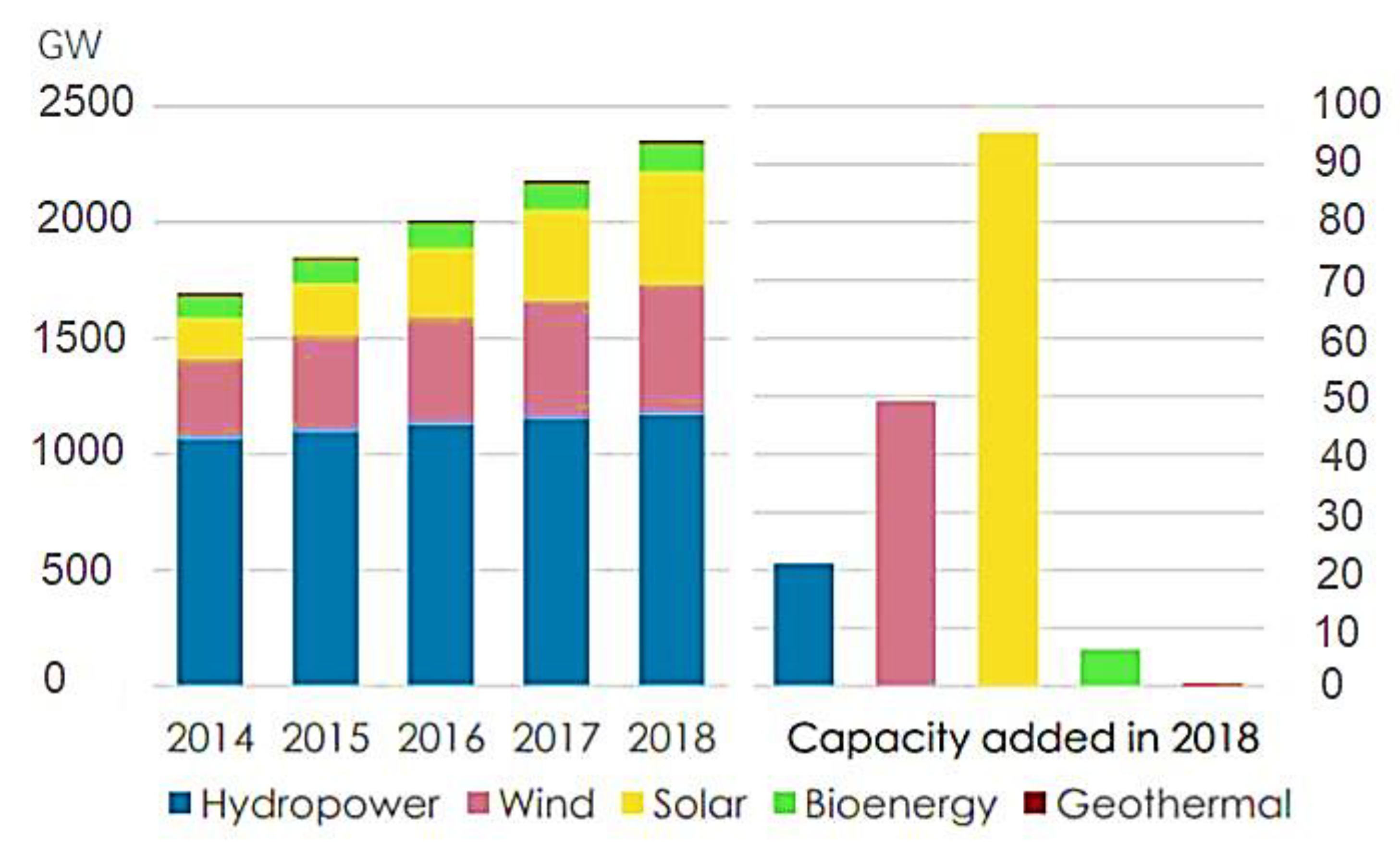
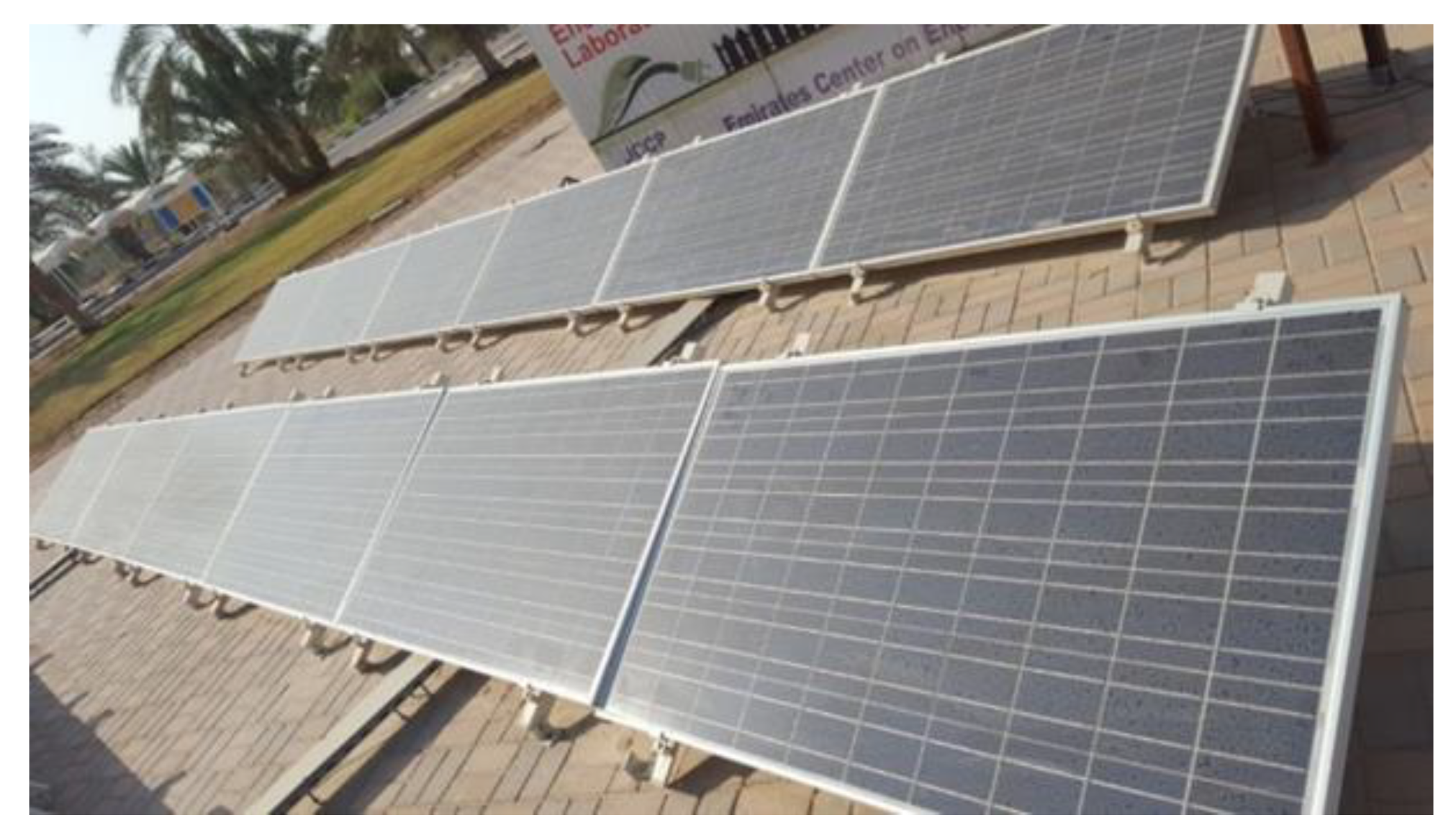
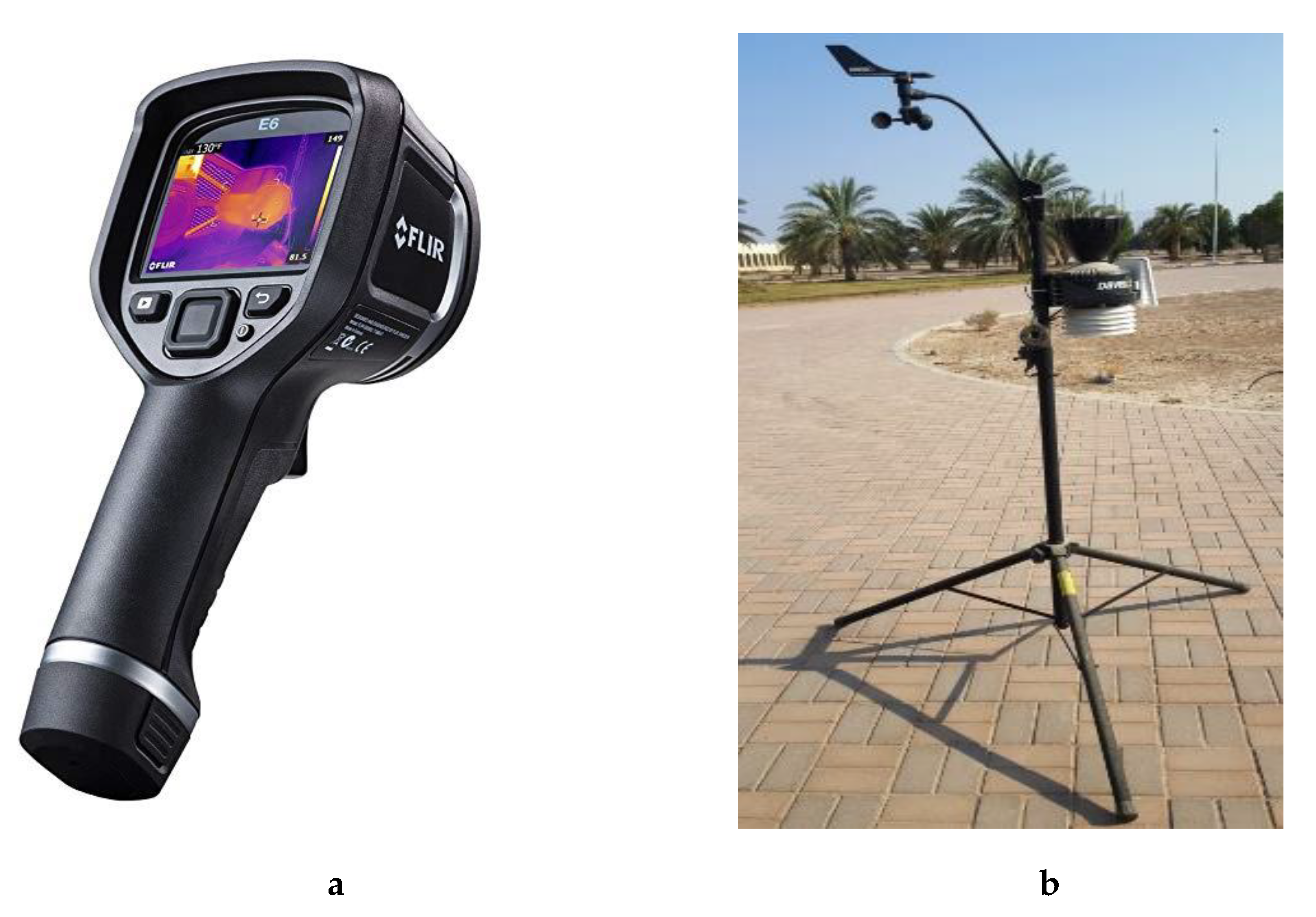

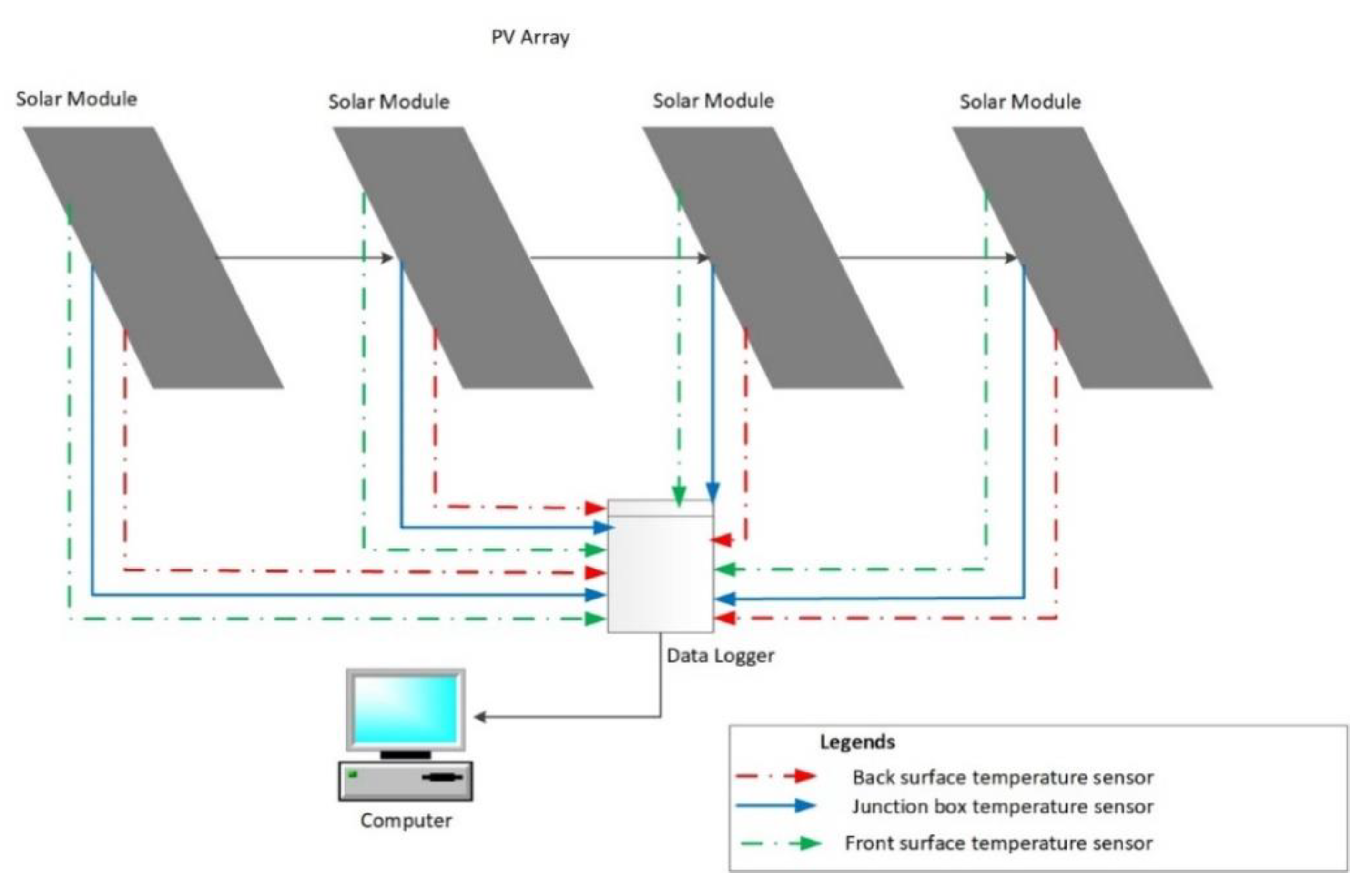
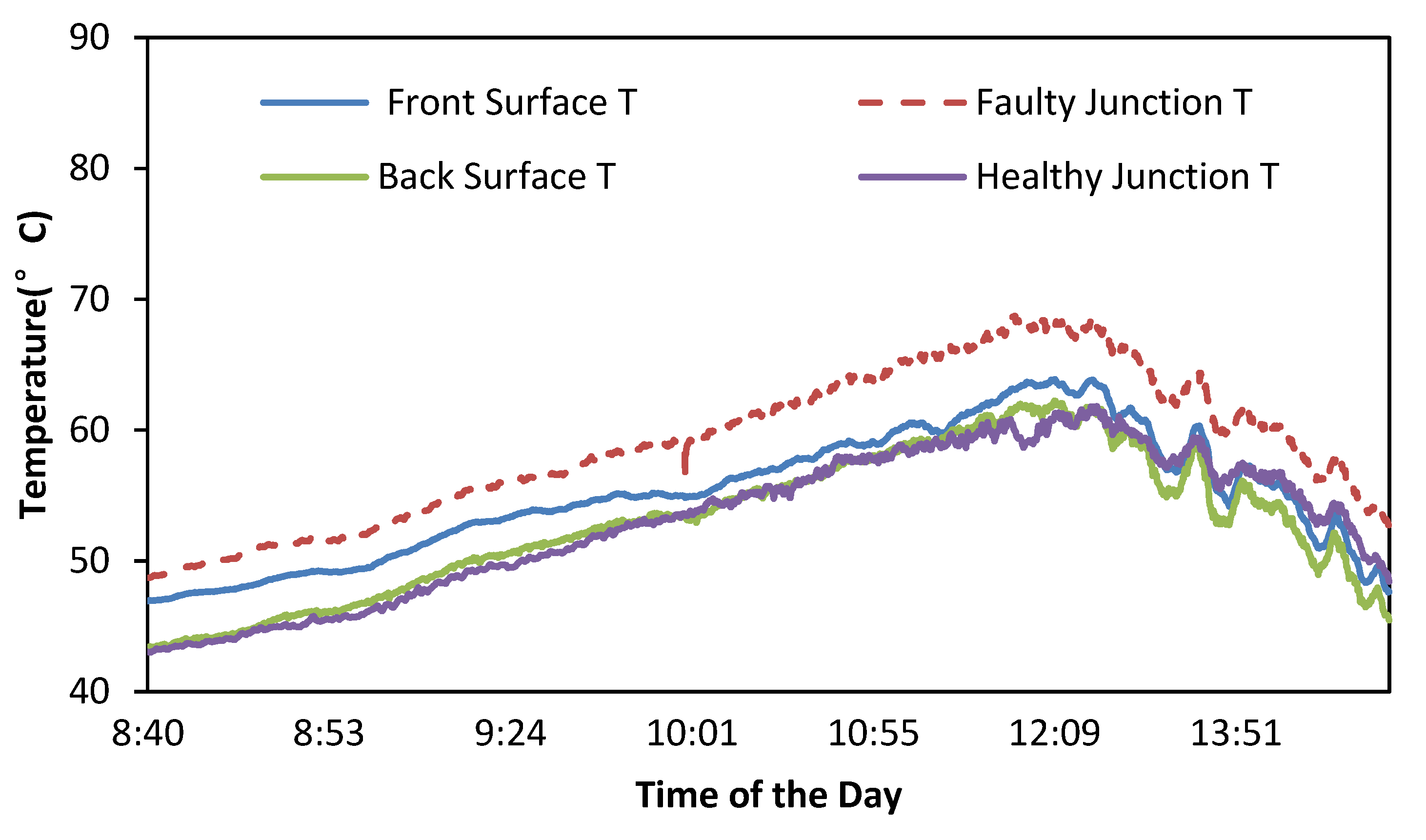

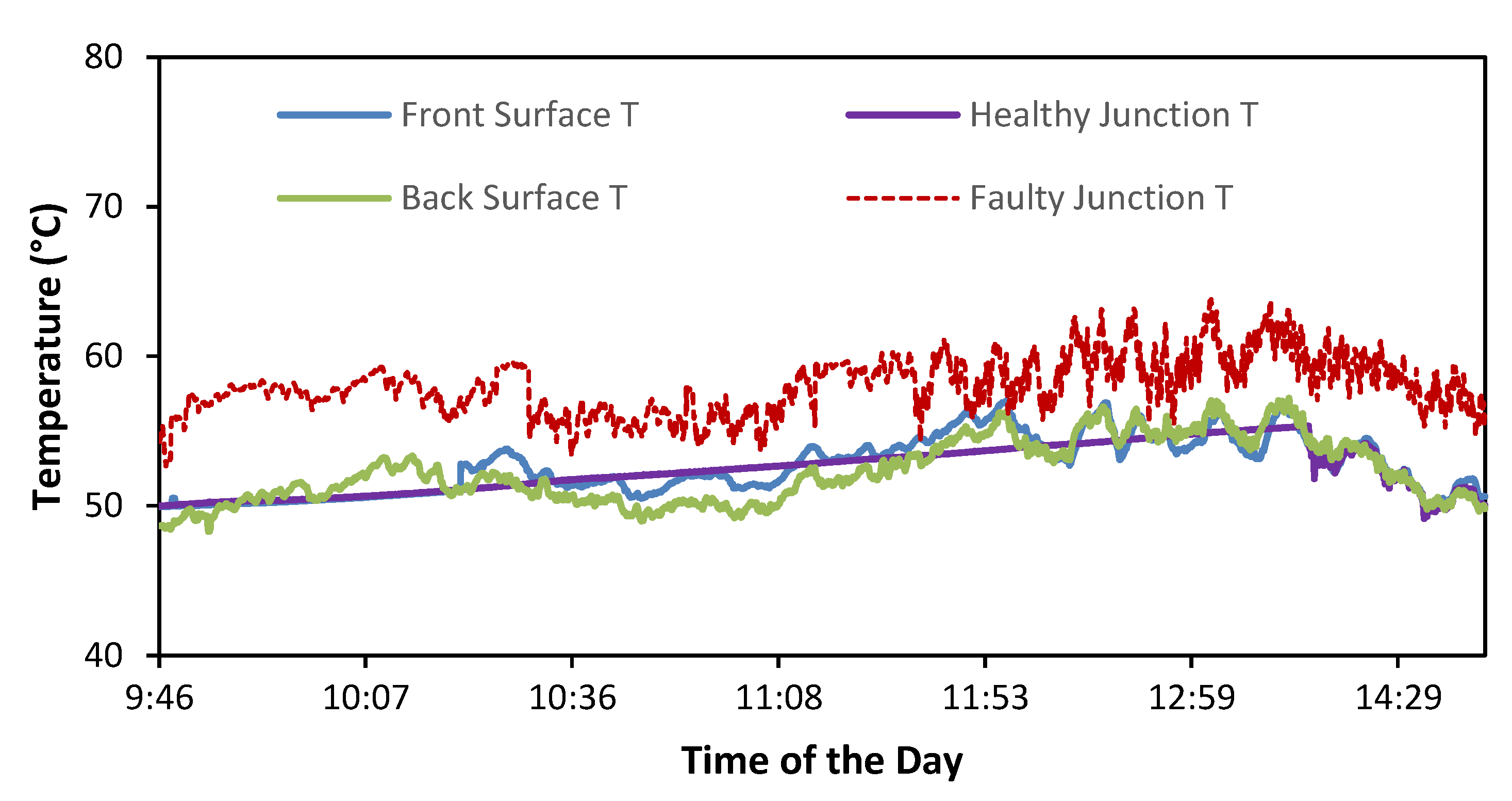

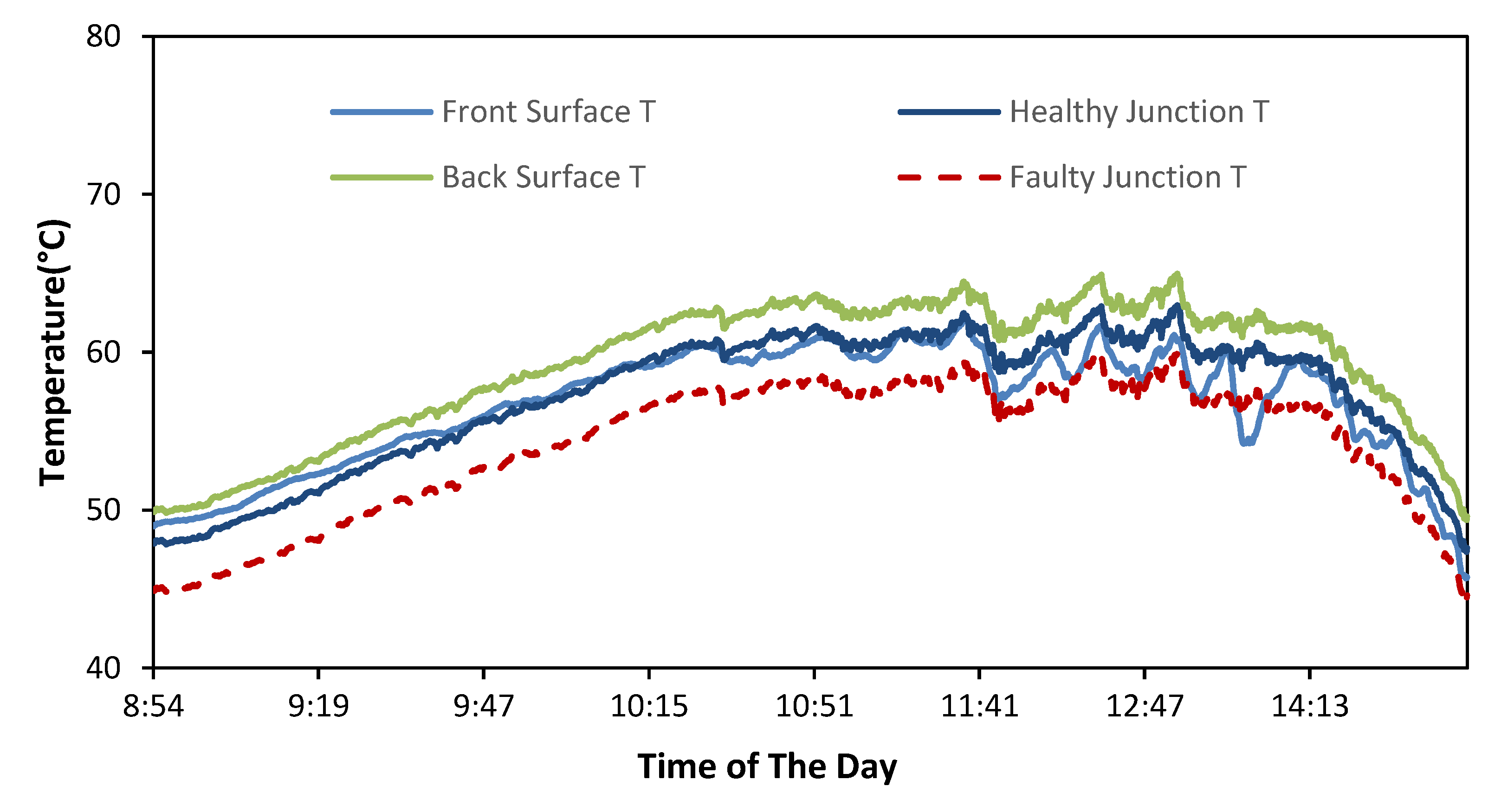
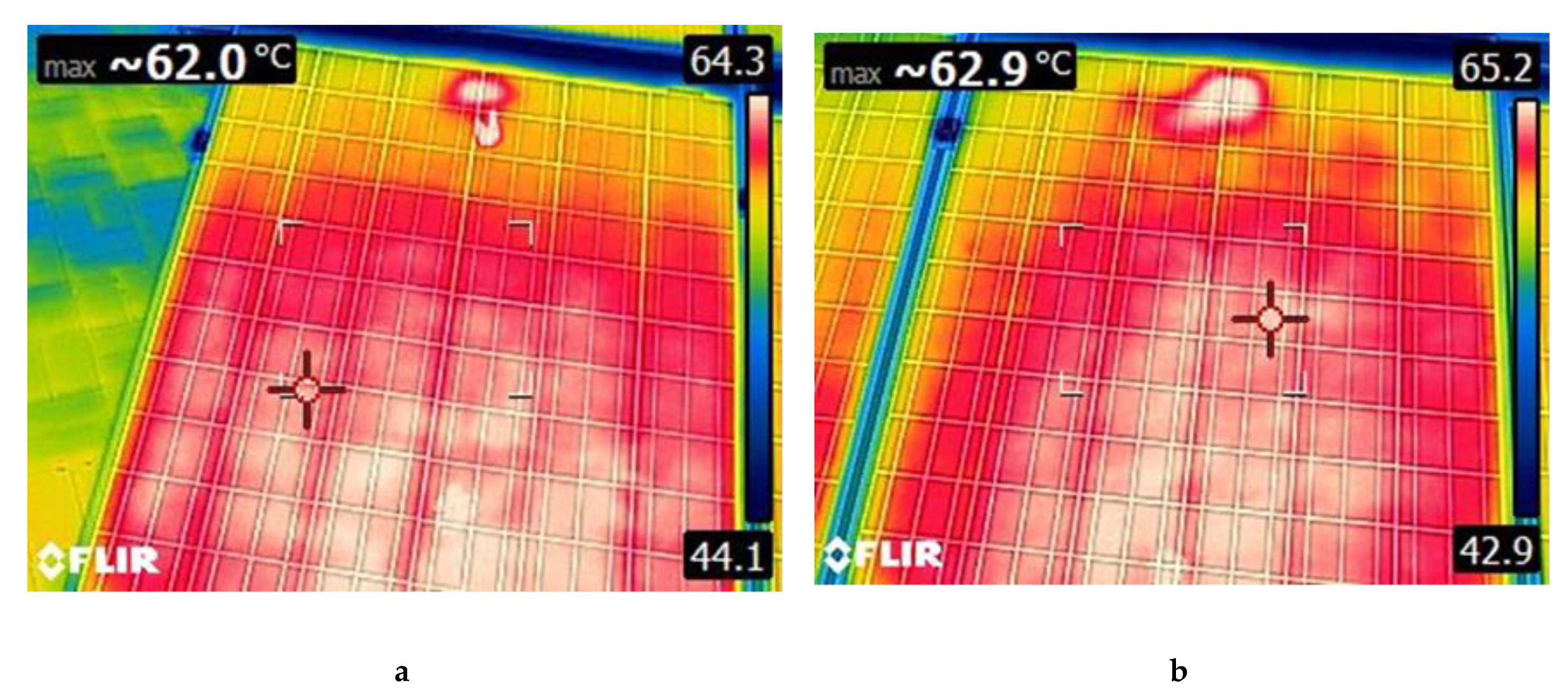

| Pmax | 160 ±3% |
| Vmax | 36.20 |
| Imax | 4.59 |
| Voc | 43.32 |
| Isc | 5.05 |
| Parameter Measurement | Device | Model | Measurement Value Range | Resolution |
|---|---|---|---|---|
| Data logging | National Instrument | NI-cDAQ™-9178 | ±0.02% | |
| Surface Temperature Logging | National Instrument | NI-analogue module 9213 | −75 to 250 °C | ±1% |
| Voltage Measurement | National Instrument | NI-analogue Module 9229 | −75 to 250 °C | ±1% |
| Rear Surface Temperature measurement | RS Components Ltd. | K-types Thermocouple | ±1.5% | |
| Front Surface Temperature | FLIR | FLIR-E63900 | −20 °C to +250 °C |
| No | Type of Fault | Temperature Difference (Healthy and Faulty) in the Thermal Signature Technique | Thermography | Fault Monitoring by Thermography | Fault Monitoring by Thermal Signature Technique |
|---|---|---|---|---|---|
| 1 | Short Circuit | ≥5 | 4.7 | ✓ | ✓ |
| 2 | Grounded | ≤4–5 | 2.2 | ✓ | ✓ |
| 3 | Open Circuit | ≥4 | 0.9 | No | ✓ |
| 4 | Partial Shading | ≤3 | No | ✓ |
Publisher’s Note: MDPI stays neutral with regard to jurisdictional claims in published maps and institutional affiliations. |
© 2020 by the authors. Licensee MDPI, Basel, Switzerland. This article is an open access article distributed under the terms and conditions of the Creative Commons Attribution (CC BY) license (http://creativecommons.org/licenses/by/4.0/).
Share and Cite
Navid, Q.; Hassan, A.; Ahmad Fardoun, A.; Ramzan, R. An Online Novel Two-Layered Photovoltaic Fault Monitoring Technique Based Upon the Thermal Signatures. Sustainability 2020, 12, 9607. https://doi.org/10.3390/su12229607
Navid Q, Hassan A, Ahmad Fardoun A, Ramzan R. An Online Novel Two-Layered Photovoltaic Fault Monitoring Technique Based Upon the Thermal Signatures. Sustainability. 2020; 12(22):9607. https://doi.org/10.3390/su12229607
Chicago/Turabian StyleNavid, Qamar, Ahmed Hassan, Abbas Ahmad Fardoun, and Rashad Ramzan. 2020. "An Online Novel Two-Layered Photovoltaic Fault Monitoring Technique Based Upon the Thermal Signatures" Sustainability 12, no. 22: 9607. https://doi.org/10.3390/su12229607






